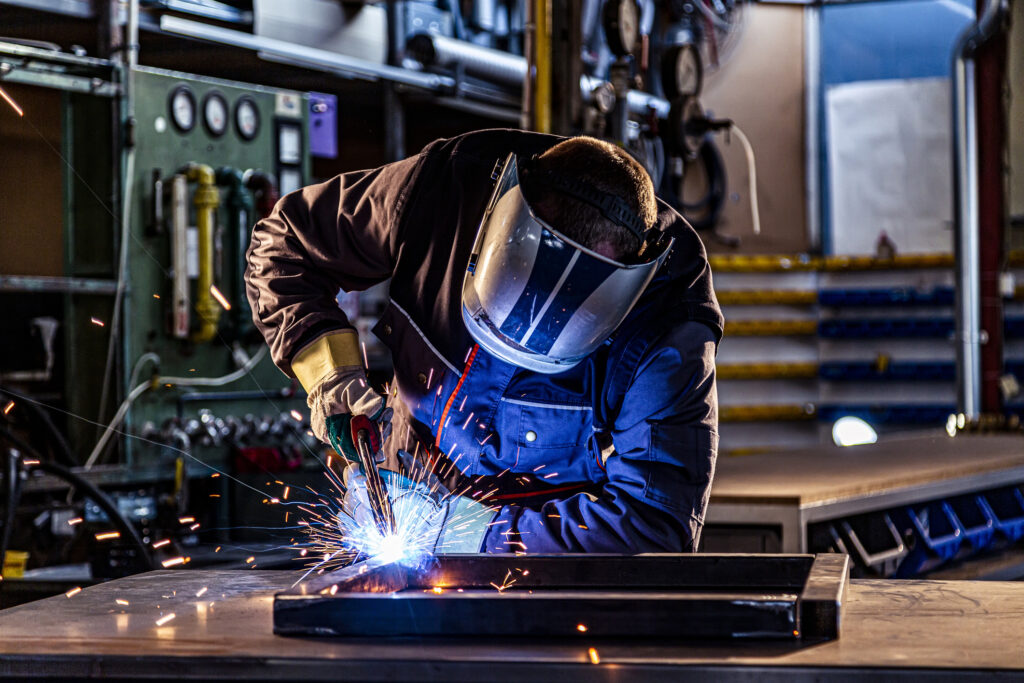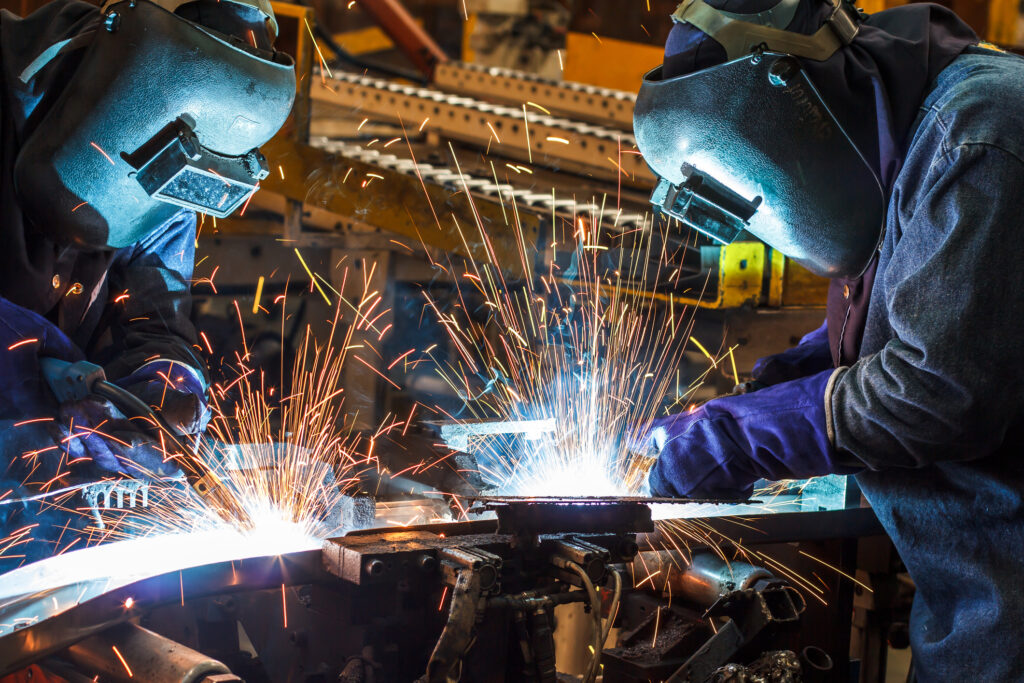Electron beam welding - principle, advantages & disadvantages, devices, use & cost-effectiveness
In the electron beam welding process, also known as electron beam welding or EB welding for short, the material is melted by the impact of highly accelerated electrons on the workpiece surface. This converts kinetic energy into heat.
Table of contents
- Electron beam welding - principle, advantages & disadvantages, devices, use & cost-effectiveness
- What is electron beam welding?
- What are the advantages of electron beam welding?
- What are the disadvantages of electron beam welding?
- How does electron beam welding without vacuum work?
- How works the principle of electron beam welding?
- Which devices are needed and which are the protective measures?
- How economic efficiency is electron beam welding?
- How is electron beam welding used?
- The welders for electron beam welding
Estimated reading time: 9 minutes
What is electron beam welding?
Electron beam welding takes place in a vacuum. This means that no shielding gases are required. Electrons are directed onto the workpiece, where they convert their kinetic energy into heat. The efficiency is higher compared to other welding processes, including laser welding. However, X-rays are also released, so the vacuum chamber must be shielded accordingly. A lead jacket is used for this purpose. All this makes this process expensive.
The weld seams created with electron beam welding are themselves very deep and thin. Parallel seams are often produced. The welding speed is very high. This means that the heat input into the workpiece is lower, which reduces or completely eliminates distortion caused by the heat.
Electron beam welding allows metals and thermoplastics to be joined under high heat and pressure. It can also be used to weld workpieces made of different metals and even metals that are otherwise unweldable. These include metals that are chemically active, have a very high melting point or are reflective.
Thanks to the vacuum in which electron beam welding takes place, the weld seams have very good metallurgical properties. The electron beam hits the workpiece, creating a focal point. In this spot, the material quickly heats up above its melting point and partially vaporizes. The focal spot has a size of up to 100 micrometers. A vapor capillary is created in it, at the edge of which the molten pool forms.
If the beam of electrons is moved forward, the vapor capillary also moves with it. The material is continuously melted on its front side and moves from there to the rear side, where the molten material solidifies again.
What are the advantages of electron beam welding?
Electron beam welding can be used to create very precise and durable seams. It also offers the following advantages:
The vacuum
In the vacuum of 0.0001 millibar that prevails in the welding chamber, the molten material degasses immediately. This minimizes pores and there is hardly any contamination within the melting zone. There is also no need to use flux or gases, which are otherwise required to protect the weld pool. In addition, the vacuum prevents heat from being released into the ambient air, as this is not present. This increases the thermal efficiency of the process.
The vacuum chamber
The vacuum chambers are adapted precisely to the applications for which they are ordered. This reduces their volume and speeds up the process of achieving the required vacuum. This helps productivity.
Beam properties
The beam properties make it possible to determine the radiation intensity and the focusing plane. The deflection of the electron beam is also very precise, as it is almost inertia-free. This increases the productivity of the process and the quality of the seam.
Energy efficiency:
Electron beam welding makes it possible to convert 60 to 70% of the energy used into the beam power that does the work in the focal spot. This means that electron beam welding outperforms laser and arc welding.
Welding speed
Electron beam welding can achieve speeds of up to 200 millimetres per second. This reduces the distortion that occurs in the workpiece. The heat is generated in an extremely concentrated manner and only takes effect within a few milliseconds. This keeps the heat-affected zone and the weld seams extremely narrow.
Deep welding
This process is used to create very deep and at the same time very narrow seams. Temperatures of around 3,500 °C are generated at the steam capillary. This means that up to 250 mm can be welded in steel and even up to 500 mm in aluminum.
Fully automatic welding
For electron beam welding, we use our own systems that control the process automatically. This makes it easy to trace and repeat. This makes it very safe, as all work can be monitored and documented.
The metals
A very wide range of metals can be welded. In addition to steel and steel alloys, these include titanium, beryllium and zirconium, which are chemically active. There are also refractory metals such as molybdenum, niobium and tungsten. In addition, metals such as copper, whose surface is reflective, can be melted, as the beam of electrons acts independently of the wavelength.
What are the disadvantages of electron beam welding?
Of course, in addition to the advantages, there are also certain disadvantages. For example, the application of electron beam welding is completely automatic. Accordingly, the individual parts to be joined would have to be prepared. No inaccuracies in the production of the individual components are compensated for here. These must be ready for assembly.
The actual welding in the working chamber takes place in a vacuum. This chamber must therefore be evacuated. The air extraction takes a few minutes. However, this time is less of an obstacle, as setting up and preparing the parts takes more time here.
Designed for mass production, the work chambers can join several components at the same time. This means that the time required for evacuation is only a few seconds per part. The vacuum protects the components far better than a shielding gas can.
How does electron beam welding without vacuum work?
Electron beam welding is also possible without a vacuum. However, this has considerable disadvantages. It starts with the fact that the beam is slowed down and the focal point is widened. This makes the weld seam less deep and also wider. For this reason, only workpieces with a maximum thickness of 8 mm are welded.

How works the principle of electron beam welding?
A tungsten cathode is used for electron beam welding. This is located in a vacuum and heats up to a temperature of 2,800 °C. This generates a large quantity of free electrons. Magnetic and electric fields then bundle the electrons into a beam. High voltages of between 60 and 150 kV are used to accelerate the electrons to at least 150,000 kilometers per second.
Even with only a small mass, the electrons have a very high kinetic energy at this speed. They are concentrated in the focal spot and hit the material, where they immediately vaporize it with this energy.
Which devices are needed and which are the protective measures?
Electron beam welding is carried out using complete machines. These consist of a working chamber in which the actual welding processes take place, a beam generator, vacuum pumps, a voltage source and an electronic control system.
The source of the high voltage is protected in such a way that it cannot be touched. The vacuum chamber also protects against the outside air and the X-rays generated inside.
Each machine is manufactured according to the specifications of the applications for which they are intended. This means that they are configured precisely for their tasks. The applications themselves are defined by the user, who can also combine other requirements with them. The machine is then built and delivered accordingly. It comes with various precautions and regulations for safe use that employees must follow.
How economic efficiency is electron beam welding?
The machine required for electron beam welding costs roughly the same as a laser beam system in the same performance class. However, the running costs for the work are lower. In electron beam welding, there is only one wearing part in the machine and that is the cathode. This is already available for less than 100 euros.
No material components are used to shape the electron beam. This means that nothing can become contaminated. The workpiece receives 50% of the total power used throughout the entire process, from the power source to heat generation.
The result of electron beam welding is of a very high quality. This means that the costs are offset by considerable added value.
How is electron beam welding used?
Electron beam welding is primarily used in the aerospace and automotive industries. Other sectors include mechanical engineering, electrical and energy technology, precision engineering and medical technology.
This method has been used in all of these areas for decades and the results are very good. The process is also gaining ground in the areas of rail vehicle construction, crane and plant construction. However, there are certain regulations that stand in the way of approval, which were originally issued for arc welding. These would have to be extended for electron beam welding to be used more widely in these areas.
The welders for electron beam welding
The personnel who use the machines for electron beam welding must be trained accordingly. The training process is comparable to training on other machine tools. The details of generating and shaping the electron beam are taught.
This is complemented by an understanding of the functions of the machine and the sequence of the process. This is rounded off by lessons on processing technologies, welding metallurgy and quality assurance. At the end, there is a little teaching material on electron beam-compatible design.
All courses have a theoretical and a practical part. This enables course participants to acquire the necessary knowledge and also learn how to apply it in practice.
Training in the use of electron beam welding machines is aimed at technicians and engineers. In addition, there are master craftsmen and skilled workers who have already gained experience with the use of electron beams.
The areas of activity of those to whom the training is aimed include personnel working in the field of production and welding. It can also be used to train planners, managers and designers.
More about welding
